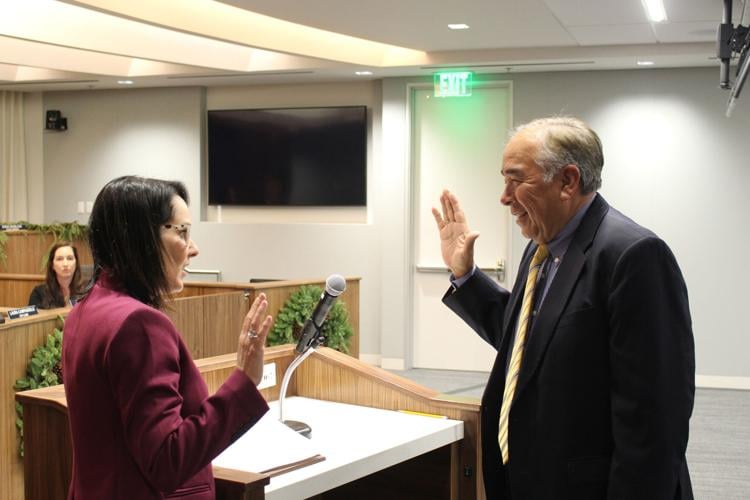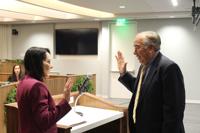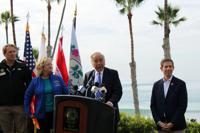After 35 years of various senior-level management positions, Victor Cabral wanted to give back to what he called an “extraordinary city with a great future” by serving on the San Clemente City Council, and he used the encouragement of others to run for office.
Now over a year after his election, and weeks after being appointed to the city’s mayoral position for 2024, Cabral looks to build on what he called a “successful” 2023 when the council returns on Jan. 16.
Chiefly, the new mayor felt the council accomplished the most relating to public safety and San Clemente’s eroding shorelines.
North Beach went from a place that many residents complained about to the council to an area that has received more positive feedback in recent months, according to Cabral.
“We were able to address a lot of the issues of people drinking and smoking and loitering on the beach with no useful purpose,” he said. “We were able to transition that into a beach that’s useful to the community and (to) families, where people feel safe and secure.”
Following City Manager Andy Hall’s presentation of his North Beach Placemaking Plan, which placed an emphasis on increasing public safety among other recommendations, the council traversed a winding path to bringing uniformed personnel to North Beach and San Clemente’s downtown area.
In May, the council authorized over $1.2 million in spending to have four deputies monitor a new patrol area comprising North Beach and the “T-Zone.” The next month, after Cabral and Councilmember Steve Knoblock interviewed various private security firms as part of a subcommittee, the council approved a six-month contract worth over $300,000 with Allied Universal Security Solutions.
Those efforts, combined with the work of the city’s two Community Outreach Workers, made a significant amount of progress in Cabral’s view.
“People forget that we also do a lot of work to move people into permanent supportive housing, to give them counseling, to give transportation,” he said. “It’s a comprehensive program that our city engaged in to address that, and I think it worked.”
Speaking to the events that brought more Police Services and private security personnel to San Clemente, Cabral prefaced his thoughts by saying he felt Police Services, which are “primarily responsible” for public safety in the city, have many responsibilities. Most of those responsibilities concern real threats to people’s safety, he said, which doesn’t leave deputies with the time to address the less dangerous issues that emerged at North Beach and the southern part of town more recently.

Photo: C. Jayden Smith
“(With) those kinds of issues, you can’t afford to have law enforcement observing (them) all the time, and we thought we would supplement the police efforts with private security,” Cabral explained. “That was my thought, because your private security can observe more, (and) they can spend more time at the various locations that are hotspots in the city.”
As the city continues its attempts to establish a more comprehensive Park Ranger program that gives department personnel citation authority, the private security would be able to address the city’s short-term needs, the mayor added.
“One of our objectives this year, (or) at least one of mine is, developing that (Park Ranger) program,” Cabral continued. “We did hire a senior ranger official, (and) we want to make that a substitute for our private security so that way, we have more control. We want to enhance their security and training and give them citation authority so they can be more accountable to the city.”
Regarding the city’s beaches, Cabral referenced the move to contract with Leslea Meyerhoff of Summit Environmental Group for three years. With Meyerhoff on board, the city had someone fully dedicated to protecting the beaches and someone who would be accountable for the beaches’ conditions going forward.
“We had, I think, five different people (who were) department heads that each had a little piece of the beach …” said Cabral. “Everybody had a little piece of it, but nobody truly had a responsibility for restoring our beaches.”
Calling Meyerhoff a “world-class leader” in beach restoration efforts, Cabral added that Meyerhoff is doing everything possible to address the issues facing the city’s coastline.
Other people that the council will continue to work with in 2024 include Hall and City Attorney Elizabeth Mitchell, both of whom joined the city early last year.
Cabral said both have been extraordinary, saying that Hall has made the city’s transition to a new manager easy with his ability to work well with others.
“He has a lot of experience in being the city manager, and as a result of his experience, he has given me insight into a number of options and approaches to take that I would have never thought of by myself,” said Cabral. “He has really been a guiding force for me and, I think, other members of the City Council in addressing issues and attacking them in new ways that I never knew of or thought possible.”
The new mayor also praised Mitchell for her sound advice and work to reduce the city’s legal costs, a factor that has been too high in recent years, according to Cabral.
The year 2024 will be another significant one regarding the city’s beach situation, as Cabral pointed to the ongoing first phase of the San Clemente Shoreline Project that is anticipated to conclude by the end of January or early February.
While bringing sand onto the beach is a monumental achievement, Cabral mentioned the need to look ahead to future phases in which the city will be required to contribute more money. By the time 2030 approaches in time for Phase II, San Clemente must contribute $10 million, funding the city currently doesn’t have available.
Cabral said one of his priorities for this year will be determining funding options.
“It’ll take several years to get something in place,” he said. “It could be a (return to the) Clean Ocean fees or similar efforts, which is a parcel-by-parcel (piece) of property taxes; it could be an increase in the (Transient Occupancy Tax).”
Regardless, Cabral emphasized a need for the city to urgently establish a method to pay for future sand replenishment.
He also mentioned Meyerhoff’s work with Orange County officials to secure a regional Sand Compatibility and Opportunistic Use Program (SCOUP) permit from the state’s Division of Boating and Waterways. Such a permit would allow the city to take advantage of available sand and bring it to the city’s coastline, as there are miles of beaches that will be unaddressed by the Shoreline Project.
Other issues Cabral said he thinks will surface this year include the proposed battery storage facility east of the Talega and the city’s efforts to reformat its own website.
“It (was) one of my biggest complaints when I came on the City Council, was you couldn’t find things quickly,” he said. “We’re trying, and we want to be the best that we can be in giving our residents access to information quickly and timely, on a website that’s workable and functional.”
In terms of how Cabral will approach his role as mayor, he said the mayor’s ability to set the council agenda puts the position above simply “ceremonial-only.”
“There is a little bit more authority, and I think you also have the bully pulpit that allows you to speak to issues,” said Cabral. “It’s not a big one, (but) it still gives you a voice to prioritize issues in the public domain, which in turn affects what the City Council will want to do.”
He said being the mayor was an opportunity to prioritize and resolve issues that he feels are important to San Clemente.
“We have one of the greatest cities in California, if not the country, and to be the mayor of this city is a true honor,” Cabral said.





